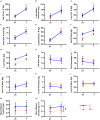Effects of Consecutive Versus Non-consecutive Days of Resistance Training on Strength, Body Composition, and Red Blood Cells
- PMID: 29967584
- PMCID: PMC6015912
- DOI: 10.3389/fphys.2018.00725
Effects of Consecutive Versus Non-consecutive Days of Resistance Training on Strength, Body Composition, and Red Blood Cells
Abstract
Health authorities worldwide recommend 2-3 days per week of resistance training (RT) performed ∼48-72 h apart. However, the influence of recovery period between RT sessions on muscle strength, body composition, and red blood cells (RBCs) are unclear. Aim: Examine the effects of three consecutive (C) or non-consecutive (NC) days of RT per week for 12 weeks on strength, body composition, and RBCs. Methods: Thirty young, healthy and recreationally active males were randomly assigned to 3 C (∼24 h between sessions) or NC (∼48-72 h between sessions) days of RT per week for 12 weeks. Both groups performed three sets of 10 repetitions at 10-repetition maximum (RM) of leg press, latissimus pulldown, leg curl, shoulder press, and leg extension for each session. Ten RM and body composition were assessed pre- and post-RT. RBC parameters were measured on the first session before RT, and 0 and 24 h post-3rd session in untrained (week 1) and trained (week 12) states. Results: No training × group interaction was found for all strength and body composition parameters (p = 0.075-0.974). Training increased strength for all exercises, bone mineral density, and total body mass via increased lean and bone mass (p < 0.001). There was no interaction (p = 0.076-0.994) and RT induced temporal changes in all RBC parameters (p < 0.001-0.003) except RBC corrected for plasma volume changes (time × training interaction; p = 0.001). Training increased hematocrit and lowered mean corpuscular hemoglobin and mean corpuscular hemoglobin concentration (p = 0.001-0.041) but did not alter uncorrected RBC, hemoglobin, mean corpuscular volume and RBC distribution width (p = 0.178-0.797). Conclusion: Both C and NC RT induced similar improvements in strength and body composition, and changes in RBC parameters.
Keywords: bone mineral density; erythrocytes; fat loss; hematology; muscle mass; muscle strength; recovery period; resistance training.
Figures


 ) and non-consecutive (NC,
) and non-consecutive (NC,  ) groups for: leg press with right leg (A), latissimus pulldown (B), leg curl with right leg (C), shoulder press (D), leg extension with right leg (E), body mass (F), lean mass (G), fat mass (H), fat percentage (I), arm fat mass (J), trunk fat mass (K), leg fat mass (L), bone mineral content (M), and bone mineral density (N). Values are means with 95% confidence interval. For (F–L), means are calculated from predicted values after adjustment for covariates. No significant training × group interaction for all parameters (p = 0.075–0.974). ∗Significant difference between UT and T states (p < 0.001). #Significant group difference between C and NC (p = 0.025).
) groups for: leg press with right leg (A), latissimus pulldown (B), leg curl with right leg (C), shoulder press (D), leg extension with right leg (E), body mass (F), lean mass (G), fat mass (H), fat percentage (I), arm fat mass (J), trunk fat mass (K), leg fat mass (L), bone mineral content (M), and bone mineral density (N). Values are means with 95% confidence interval. For (F–L), means are calculated from predicted values after adjustment for covariates. No significant training × group interaction for all parameters (p = 0.075–0.974). ∗Significant difference between UT and T states (p < 0.001). #Significant group difference between C and NC (p = 0.025).
Similar articles
-
Influence of exercise order on upper body maximum and submaximal strength gains in trained men.Clin Physiol Funct Imaging. 2013 Sep;33(5):359-63. doi: 10.1111/cpf.12036. Epub 2013 Mar 6. Clin Physiol Funct Imaging. 2013. PMID: 23701174 Clinical Trial.
-
Nonconsecutive versus consecutive-day resistance training in recreationally trained subjects.J Sports Med Phys Fitness. 2018 Mar;58(3):233-240. doi: 10.23736/S0022-4707.16.06660-3. Epub 2016 Sep 29. J Sports Med Phys Fitness. 2018. PMID: 27682004
-
Low-Load vs. High-Load Resistance Training to Failure on One Repetition Maximum Strength and Body Composition in Untrained Women.J Strength Cond Res. 2019 Jul;33(7):1737-1744. doi: 10.1519/JSC.0000000000003194. J Strength Cond Res. 2019. PMID: 31136545 Clinical Trial.
-
Effects of different resistance training frequencies on body composition and muscular performance adaptations in men.PeerJ. 2021 Apr 21;9:e10537. doi: 10.7717/peerj.10537. eCollection 2021. PeerJ. 2021. PMID: 33976952 Free PMC article.
-
Weekly Training Frequency Effects on Strength Gain: A Meta-Analysis.Sports Med Open. 2018 Aug 3;4(1):36. doi: 10.1186/s40798-018-0149-9. Sports Med Open. 2018. PMID: 30076500 Free PMC article. Review.
Cited by
-
Minimal-Dose Resistance Training for Improving Muscle Mass, Strength, and Function: A Narrative Review of Current Evidence and Practical Considerations.Sports Med. 2022 Mar;52(3):463-479. doi: 10.1007/s40279-021-01605-8. Epub 2021 Nov 25. Sports Med. 2022. PMID: 34822137 Review.
-
Universal Training Precautions: A Review of Evidence and Recommendations for Prevention of Exercise-Related Injury, Illness, and Death in Warfighters and Athletes.J Athl Train. 2023 Mar 1;58(3):232-243. doi: 10.4085/1062-6050-0400.21. J Athl Train. 2023. PMID: 35724358 Free PMC article. Review.
-
Effect of home-based hot bathing on exercise-induced adaptations associated with short-term resistance exercise training in young men.Physiol Rep. 2025 Feb;13(3):e70188. doi: 10.14814/phy2.70188. Physiol Rep. 2025. PMID: 39887948 Free PMC article.
-
Is there Evidence for the Suggestion that Fatigue Accumulates Following Resistance Exercise?Sports Med. 2022 Jan;52(1):25-36. doi: 10.1007/s40279-021-01572-0. Epub 2021 Oct 6. Sports Med. 2022. PMID: 34613589 Review.
-
Protocol for Minute Calisthenics: a randomized controlled study of a daily, habit-based, bodyweight resistance training program.BMC Public Health. 2020 Aug 15;20(1):1242. doi: 10.1186/s12889-020-09355-4. BMC Public Health. 2020. PMID: 32799849 Free PMC article. Clinical Trial.
References
-
- Ahmadizad S., El-Sayed M. S., MacLaren D. P. (2006). Effects of water intake on the responses of haemorheological variables to resistance exercise. Clin. Hemorheol. Microcirc. 35 317–327. - PubMed
LinkOut - more resources
Full Text Sources
Other Literature Sources

